igneous rocks
metamorphic
rocks
sedimentary rocks
|
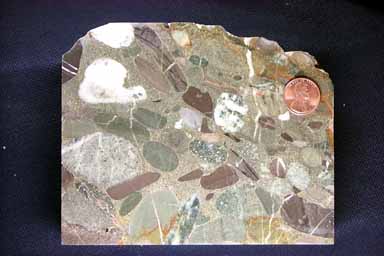
QFL Composition:
Description:
This is a sawed slab of rock that has been wet with water before photographing.
Rounded gravel particles mostly toward the upper size range of granules (4-64 mm). Lithic fragments include chert, meta-sedimentary rocks, milky (metamorphic) quartz, and occasional igneous rocks and micrite limestones. The matrix (material filling the spaces between the granules) is mostly sand, mixed with silt, and clay.
This rock is extremely immature, being low in quartz, high in gravel, poor in sphericity, and poorly sorted.
The gravel fragments tend to be elongated, but do not show a preferred orientation (i.e. are not imbricated), indicating they were probably deposited during mass transport (e.g. debris flow such as a landslide or underwater avalanche). In context of the outcrop this rock was deposited subaqueously (below water).
Tectonic Association:
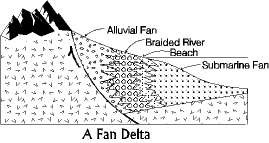 conglomerates this immature are associated with regions of high tectonic activity, typically relatively close to the sourceland. The paucity of quartz, the large size of the particles, and the poor sorting speak of short time of weathering and short distances of transportation. conglomerates this immature are associated with regions of high tectonic activity, typically relatively close to the sourceland. The paucity of quartz, the large size of the particles, and the poor sorting speak of short time of weathering and short distances of transportation.
Rocks such as this are often deposited in "Fan Deltas"
This particular specimen is the Fincastle conglomerate from the Ordovician Taconic orogeny of Virginia. From the context where it was collected it is known to have been deposited proximally in a submarine fan very near a complex volcanic arc sourceland.
Detail
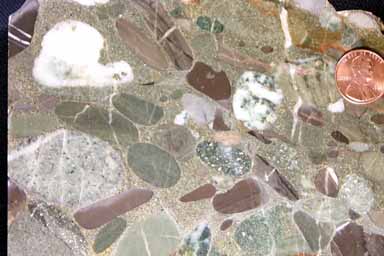
QFL Composition
Description
Rounded gravel particles mostly toward the upper size range of granules (4-64 mm). Lithic fragments include chert, meta-sedimentary rocks, milky (metamorphic) quartz, and occasional igneous rocks and micrite limestones. The matrix (material filling the spaces between the granules) is mostly sand, silt, and clay.
This rock is extremely immature, being low in quartz, high in gravel, poor in sphericity, and poorly sorted.
The gravel fragments tend to be elongated, but do not show a preferred orientation (i.e. are not imbricated), indicating they were probably deposited during mass transport (e.g. debris flow such as a landslide or underwater avalanche).
Further Detail
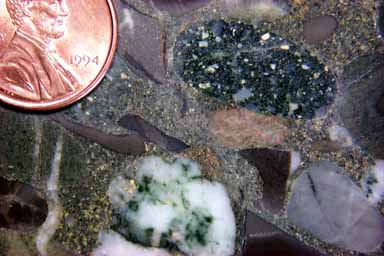
QFL Composition

The while granule (lower center) is metamorphic quartz (often precipitated in veins in the country rock); the green within it is epidote. The dark granule (upper right center) is an igneous rock. The dark gray and light gray granules (lower right) are chert. The gray granule just below the penny is a meta-sandstone.
Description
Rounded gravel particles mostly toward the upper size range of granules (4-64 mm). Lithic fragments include chert, meta-sedimentary rocks, milky (metamorphic) quartz, and occasional igneous rocks and micrite limestones. The matrix (material filling the spaces between the granules) is mostly sand mixed with silt and clay.
Further Detail
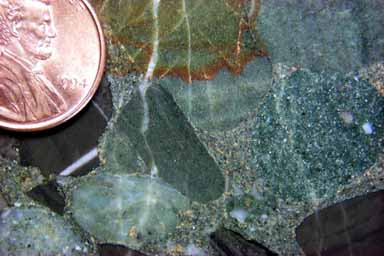
QFL Composition
Description
Rounded gravel particles mostly toward the upper size range of granules (4-64 mm). Lithic fragments include chert, meta-sedimentary rocks, milky (metamorphic) quartz, and occasional igneous rocks and micrite limestones. The matrix (material filling the spaces between the granules) is mostly sand, silt, and clay.
Another Sample
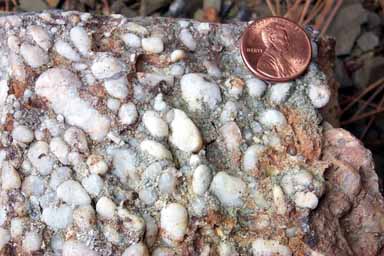
QFL Composition
Description
The quartz pebbles are obvious in this specimen, and in between the gravel you can see the quartz sand. There is some yellow-brown iron staining present, but it is secondary from the weathering of the rock.
The next two images (click pictures) show the outcrop the rock came from, and an extreme closeup of the outcrop. Because these are outcrop pictures they are not as clean as a lab specimen. The rocks are covered with lichen and dirt. But that does not change the fact that on close inspection they are quartz sandy conglomerates.
Tectonic Association
quartz rich sands and conglomerates are theoretically associated with periods of greate tectonic stability, and generally it requires those conditions to generate such rocks.
This specimen, however, comes from the middle of a clastic wedge, surrounded above and below by immature sediments. So, theory is not always right about the specific conditions in which we *find* such rocks; the natural world is just to complex to always fit our simple models. The theory is right, however, about the conditions required to *generate* such rocks.
It requires tectonic stability to generate 100% quartz sediments, and the concentration of quartz in this sample originally formed in tectonically calm conditions. The reason this rock is now found in a clastic wedge is that the quartz sand and gravel was weathered and eroded from a quartz dominated formation in the sourceland that itself was generated under tectonically quiet conditions. As the quartz rich source-land rock weathered out it released a volume of quartz pebbles and sand that washed down the rivers more or less together to be deposited in the clastic wedge, where we found this specimen.
This particular specimen comes from the Greenland Gap formation (old Chemumg) of eastern West Virginia. It is part of the Catskill clastic wedge. It was deposited either in a river or proximal submarine fan environment - in any case, a high energy environment.
Outcrop
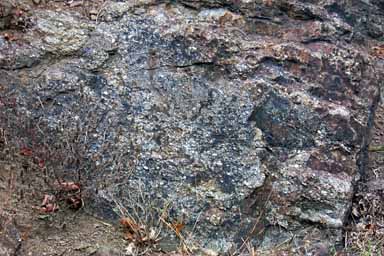
QFL Composition
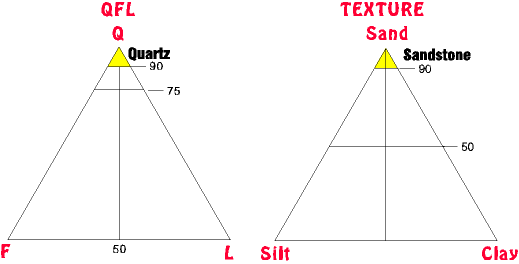
Description
Rounded gravel particles mostly toward the upper size range of granules (4-64 mm). Lithic fragments include chert, meta-sedimentary rocks, milky (metamorphic) quartz, and occasional igneous rocks and micrite limestones. The matrix (material filling the spaces between the granules) is mostly sand, silt, and clay.
This rock is extremely immature, being low in quartz, high in gravel, poor in sphericity, and poorly sorted.
The gravel fragments tend to be elongated, but do not show a preferred orientation (i.e. are not imbricated), indicating they were probably deposited during mass transport (e.g. debris flow such as a landslide or underwater avalanche).
Further Detail
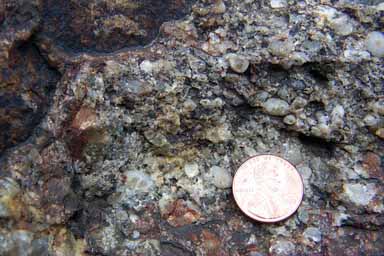
QFL Composition
Description
This view of the outcrop shows the effects of weathering with the red, yellow and brown iron staining. Yet, looking past all that noise we can see the quartz pebbles, and in between the the quartz sand.
This is a common problem in studying rocks in the field. Because they are exposed at the surface where we can get to them, they have begun to weather, and we have to learn to see through the weathering effects to the real rock below.
Further Detail
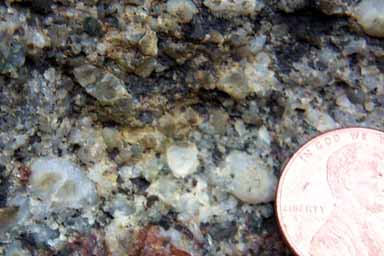
QFL Composition
Description
This view of the outcrop shows the effects of weathering with the red, yellow and brown iron staining. Yet, looking past all that noise we can see the quartz pebbles, and in between the the quartz sand.
This is a common problem in studying rocks in the field. Because they are exposed at the surface where we can get to them, they have begun to weather, and we have to learn to see through the weathering effects to the real rock below.
|